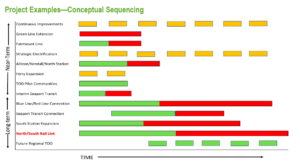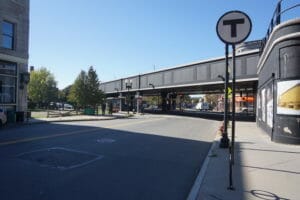Top Story
Date: October 1-6, 2017
Location: Boston, MA
Sponsor: Massachusetts Competitive Partnership
Subject Area: Regional Transportation, Real Estate Value, Transit-Oriented Development
Panel Chair: Marilee Utter, President, Citiventure Associates
Background and Panel Assignment
 The Greater Boston Region comprises 164 cities and towns throughout eastern Massachusetts, which are home to more than 4.45 million people. During the late 19th century, the region’s rail systems were built with multiple terminals constructed and few connections built between the lines. The private lines were consolidated into two separate stub-end stations – the North and South stations. Today, no physical connection exists between these two stations. To remedy this issue, the North South Rail Link was proposed as a 2.8-mile tunnel to connect the two stations and form a unified regional rail network allowing for through-running service between the separate northern and southern commuter rail networks.
The Greater Boston Region comprises 164 cities and towns throughout eastern Massachusetts, which are home to more than 4.45 million people. During the late 19th century, the region’s rail systems were built with multiple terminals constructed and few connections built between the lines. The private lines were consolidated into two separate stub-end stations – the North and South stations. Today, no physical connection exists between these two stations. To remedy this issue, the North South Rail Link was proposed as a 2.8-mile tunnel to connect the two stations and form a unified regional rail network allowing for through-running service between the separate northern and southern commuter rail networks.
The Advisory Services Panel was asked how a North South Rail Link would impact regional transportation and real estate value within the Boston region and downtown specifically. In addition, the panel was asked to consider how a South Station expansion would impact real estate development and value.
Key Recommendations
The panel made the following key recommendations, addressing the impacts of North South Rail Link on downtown Boston real estate and more broadly the regional implications of a unified regional rail system:
- The guiding principles for investment in any major transportation project must be the criteria for any major transportation project decision-making process. The principles include: linking housing to jobs; ability to leverage public/private resources; increases social equity; preserves core, high-value land, for real estate for development; and, builds climate resilience. Following these principles will ensure that the Greater Boston region remains economically competitive and the transportation system meets the growth projections for the next 30 years.
- The regional rail network is an invaluable regional asset that should be viewed as a comprehensive system, requiring – and worthy of – substantial coordinated and prioritized investments over time. This will ensure that the North South Rail Link will have positive future real estate impact by mitigating the loss of at risk downtown real estate and facilitate regional economic development opportunities. The North South Rail Link could have significant real estate impacts surrounding South Station and within Widett Circle whereas minimal real estate impacts would occur surrounding the North Station and the proposed Central or Union Station due to the amount of development that has already occurred in these areas.
- The South Station Expansion’s Environmental Impact Station should be amended to ensure a substantial real estate component be considered as a compliment to a future North South Rail Link. Doing so ensures a more regional systematic approach to transportation planning. Planning for complimentary projects may eliminate, or alleviate, the need for increased layover capacity within Widett Circle while still enabling increased regional transportation capacity that will be required over the long-term. Temporary tracks may be required within Widett Circle if both projects are to move forward.
- Transit Oriented Development (TOD) station area plans should be developed to provide a framework for real estate development to occur along all MBTA lines. Core land within the city of Boston is precious and will soon be built out and already boasts incredibly high land values (e.g. to expensive). Transit and subsequently the development opportunities it can create will create access for more affordable choices which is critical to continued regional economic vitality. TOD station area plans should include a clear vision that identifies local champions, opportunities for development, a clear articulation of necessary entitlements and incentives, and collaborative strategies to develop first mile/last mile connections . Simply having access to a station is not enough to ensure that development happens. A regional approach to TOD is required.
- Housing supply should be greatly increased to meet the projected regional growth anticipated over the next 30 years. This will require increased density for housing within the Greater Boston region. More than 300 to 400 thousand units are projected to be required, but only 10 to 13 thousand units are being created annually, increasing the cost of housing and threating the region’s future prosperity.
- To remain economically competitive, the Greater Boston Area needs to cooperate regionally to compete globally. Partnerships between the state, metro mayors’ forum, regional planning groups, business groups, and advocates will need to be strengthened and expanded. There are so many governmental and nongovernmental organizations in the Greater Boston area, and a stronger coordination and communication strategy is necessary to attract maximum investment from the federal government and private infrastructure investors. This will enable Boston to compete against regions like London, Tokyo, and Washington, D.C. not the North Shore verses the South Shore.
